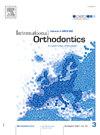Accuracy of cephalometric landmark identification by artificial intelligence platform versus expert orthodontist in unilateral cleft palate patients: A retrospective study
IF 1.9
Q2 DENTISTRY, ORAL SURGERY & MEDICINE
引用次数: 0
Abstract
Objective
The primary aim of the study was to evaluate the accuracy of automated artificial intelligence (AI) cephalometric landmark identification in cleft patients and compare it to landmarks identified by an expert orthodontist. The secondary objective was to compare cephalometric measurements obtained by both methods.
Material and methods
A total of 112 pre-treatment lateral cephalometric radiographs of unilateral cleft palate patients were collected from the archives of the Department of Orthodontics, Faculty of Dentistry, Alexandria University following screening of all the records of patients treated in the period January 2019–December 2022 for eligibility. For each of the acquired radiographs, cephalometric tracing was performed by fully automated WebCeph™ landmark detection process and by manual identification of the landmarks by an expert orthodontist using OnyxCeph™ software. The traced radiographs were then imported into Photoshop software for evaluation of the (x,y) coordinates, in mm, for each of the identified landmarks (Primary outcome). Moreover, linear and angular measurements generated using WebCeph™ and OnyxCeph™ software were compared (secondary outcomes).
Results
The coordinates of A-point, ANS, and Or showed statistically significant differences between both identification methods, with a mean difference between the two methods ranging between –0.86 mm ± 2.15 and 3.15 mm ± 6.07. None of the dental landmarks showed statistically significant differences between the two methods. None of the soft tissue landmarks showed statistically significant differences, except Ns y-coordinate. Several points showed clinically significant differences between both methods. The greatest mean differences in cephalometric measurements between the two methods were reported in nasolabial angle CotgSnLs (18.3 ± 22.77 ̊) followed by Max1-NA (–8.86 ± 17.46 ̊) and Max1-SN (–8.43 ± 12.51 ̊).
Conclusions
The identification of cephalometric landmarks in cleft palate patients using the web-based AI platform is not as accurate as manual identification. Manual adjustment of landmarks following AI identification is advised.
人工智能平台与专家正畸医师对单侧腭裂患者头颅测量地标识别准确性的回顾性研究
目的本研究的主要目的是评估自动人工智能(AI)头颅测量识别腭裂患者地标的准确性,并将其与专家正畸医生识别的地标进行比较。次要目的是比较两种方法获得的头颅测量结果。材料与方法对2019年1月- 2022年12月期间治疗的所有患者记录进行筛选,从亚历山大大学牙科学院正畸科档案中收集单侧腭裂患者治疗前侧位头颅x线片112张。对于每一张获得的x线片,通过全自动WebCeph™地标检测过程和由专家正畸医生使用OnyxCeph™软件手动识别地标进行头部测量追踪。然后将追踪的x线照片导入Photoshop软件中,以mm为单位评估每个已识别地标的(x,y)坐标(主要结果)。此外,比较使用WebCeph™和OnyxCeph™软件生成的线性和角度测量值(次要结果)。结果两种方法的a点坐标、ANS坐标和Or坐标差异均有统计学意义,平均差异为-0.86 mm±2.15和3.15 mm±6.07。两种方法的牙标均无统计学差异。除Ns - y坐标外,其他软组织标记均无统计学差异。两种方法在若干点上有显著的临床差异。两种方法测量的平均差异最大的是鼻唇角CotgSnLs(18.3±22.77),其次是Max1-NA(-8.86±17.46)和Max1-SN(-8.43±12.51)。结论基于web的人工智能平台识别腭裂患者的头侧标志的准确性不如人工识别。建议在人工智能识别后手动调整地标。
本文章由计算机程序翻译,如有差异,请以英文原文为准。
求助全文
约1分钟内获得全文
求助全文
来源期刊

International Orthodontics
DENTISTRY, ORAL SURGERY & MEDICINE-
CiteScore
2.50
自引率
13.30%
发文量
71
审稿时长
26 days
期刊介绍:
Une revue de référence dans le domaine de orthodontie et des disciplines frontières Your reference in dentofacial orthopedics International Orthodontics adresse aux orthodontistes, aux dentistes, aux stomatologistes, aux chirurgiens maxillo-faciaux et aux plasticiens de la face, ainsi quà leurs assistant(e)s. International Orthodontics is addressed to orthodontists, dentists, stomatologists, maxillofacial surgeons and facial plastic surgeons, as well as their assistants.
 求助内容:
求助内容: 应助结果提醒方式:
应助结果提醒方式:


